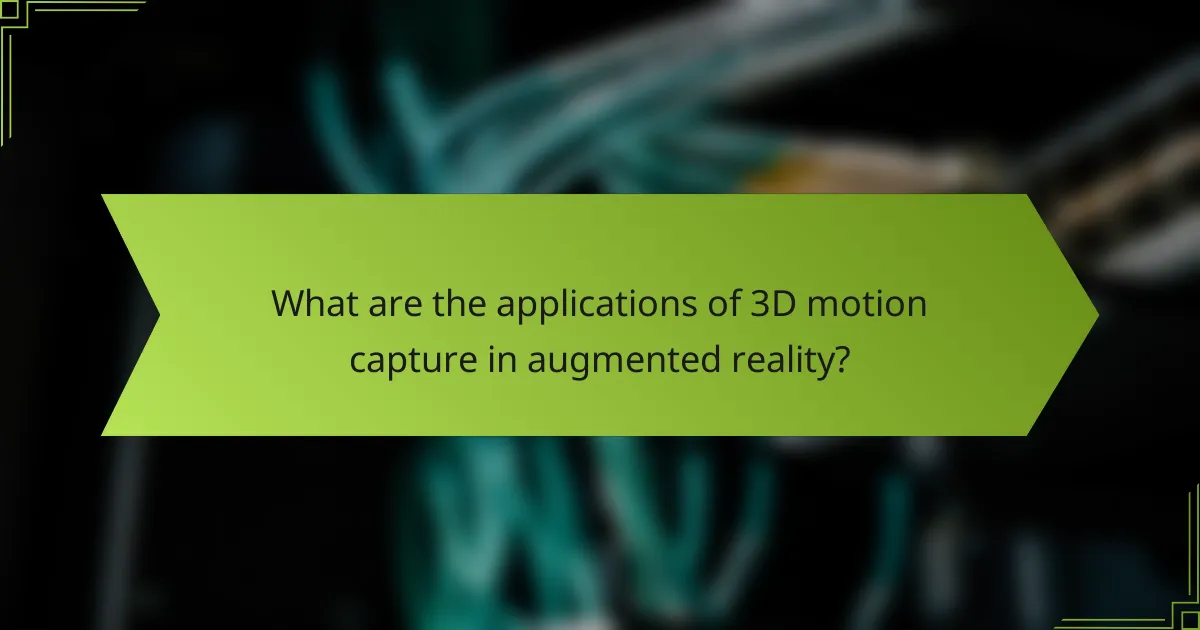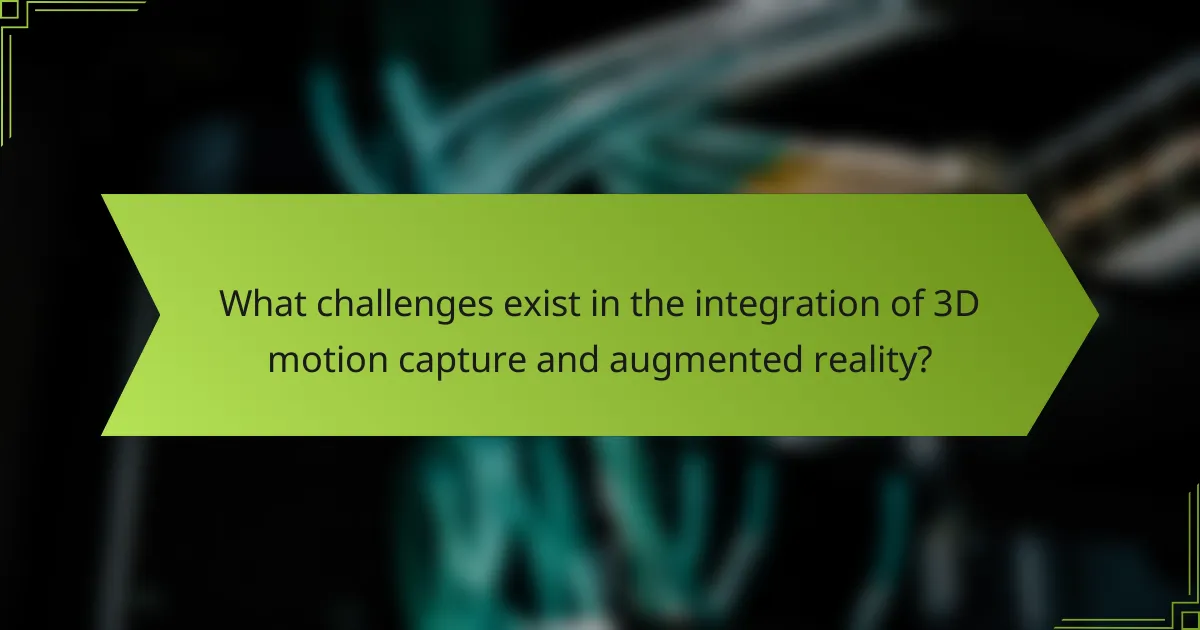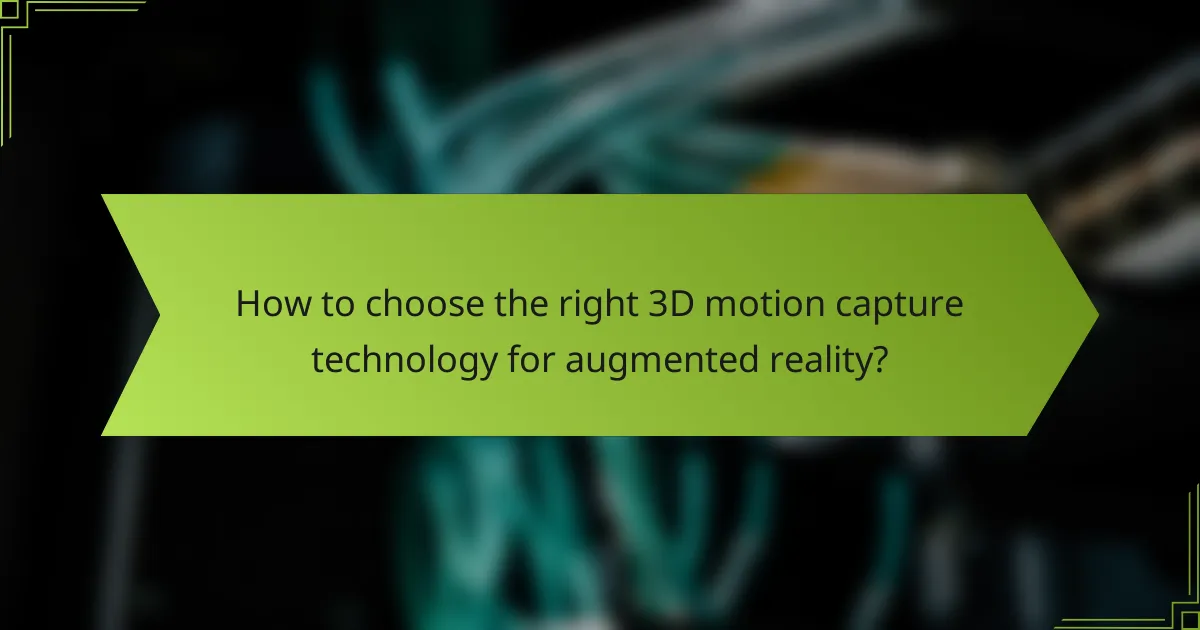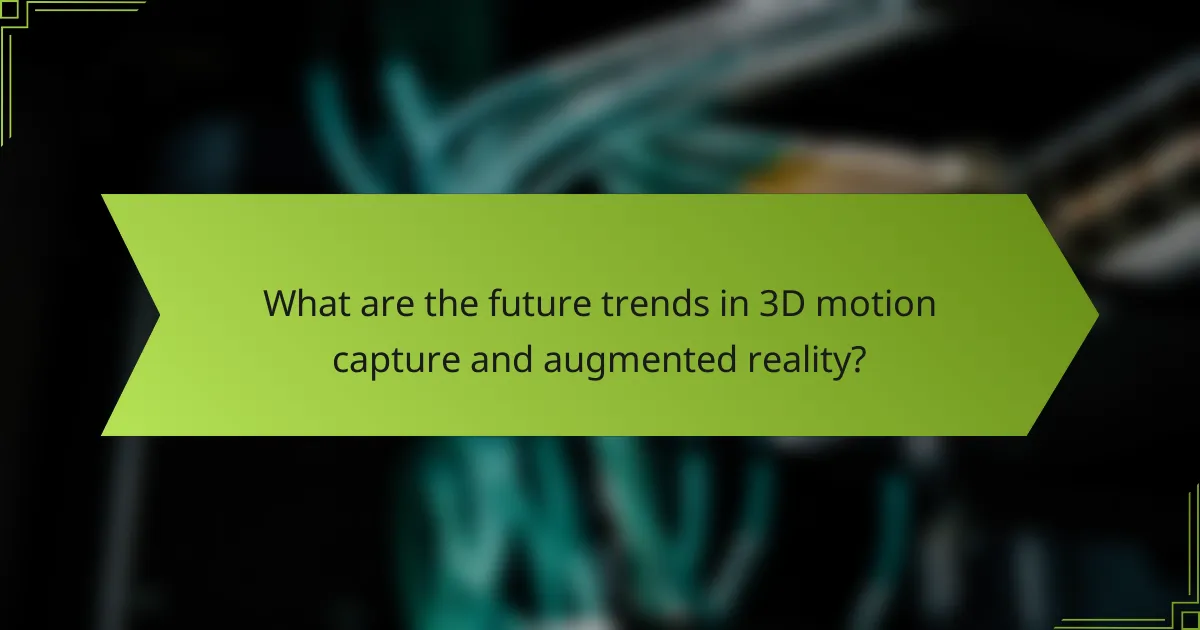The integration of 3D motion capture technology with augmented reality (AR) is revolutionizing user experiences by enabling realistic interactions and visualizations across diverse sectors. This synergy enhances applications in gaming, healthcare, education, virtual tourism, and sports analytics, creating immersive environments that respond dynamically to user movements. However, challenges such as technical limitations, high costs, and data privacy concerns must be addressed to fully realize its potential.

What are the applications of 3D motion capture in augmented reality?
3D motion capture technology is increasingly integrated with augmented reality (AR) across various sectors, enhancing user experiences by providing realistic interactions and visualizations. Key applications include gaming, healthcare, education, virtual tourism, and sports analytics.
Gaming and entertainment
In gaming and entertainment, 3D motion capture allows players to engage in immersive experiences by translating their movements into the game environment. This technology enables real-time interaction with virtual characters, creating a more dynamic and engaging gameplay experience.
Examples include games that use body tracking to control characters or movements, enhancing the realism and enjoyment. Developers often utilize motion capture to create lifelike animations, making characters more relatable and engaging for players.
Healthcare and rehabilitation
3D motion capture plays a significant role in healthcare, particularly in rehabilitation settings. It allows for precise tracking of patient movements, enabling healthcare professionals to assess progress and tailor rehabilitation programs effectively.
For instance, physical therapists can use motion capture to analyze a patient’s gait or posture, providing immediate feedback and adjustments to treatment plans. This technology can also enhance patient engagement by making rehabilitation exercises more interactive and enjoyable.
Education and training
In education and training, 3D motion capture enhances learning experiences by providing interactive simulations. This technology allows students to engage with complex subjects, such as anatomy or physics, through realistic visualizations and hands-on activities.
For example, medical students can practice surgical techniques in a simulated environment, gaining valuable experience without the risks associated with real-life procedures. This approach fosters deeper understanding and retention of knowledge.
Virtual tourism
Virtual tourism leverages 3D motion capture to create immersive travel experiences, allowing users to explore destinations from the comfort of their homes. This technology can simulate walking tours, enabling users to interact with their surroundings in a lifelike manner.
Travel companies can use motion capture to enhance promotional materials, providing potential travelers with a taste of the experiences they can expect. This application can be particularly beneficial during travel restrictions, maintaining interest in destinations.
Sports analytics
In sports analytics, 3D motion capture provides detailed insights into athlete performance by tracking movements and techniques. Coaches and analysts can use this data to identify strengths and weaknesses, informing training strategies and improving performance.
For example, motion capture can analyze a runner’s stride or a swimmer’s technique, offering precise metrics that can lead to targeted improvements. This data-driven approach helps athletes optimize their training regimens and achieve better results in competitions.

What are the benefits of integrating 3D motion capture with augmented reality?
Integrating 3D motion capture with augmented reality (AR) enhances the overall experience by creating immersive environments that respond to user movements. This combination offers significant advantages across various sectors, including entertainment, education, and healthcare.
Enhanced user experience
The integration of 3D motion capture with AR significantly improves user engagement by providing interactive and immersive experiences. For instance, in gaming, players can physically move and interact with virtual elements, making the gameplay more intuitive and enjoyable.
In educational settings, students can visualize complex concepts in 3D, leading to better retention and understanding. This hands-on approach allows learners to explore subjects like anatomy or physics in a more dynamic way.
Real-time interaction
Real-time interaction is a key benefit of combining 3D motion capture with AR, allowing users to see immediate responses to their movements. This capability is crucial in applications such as virtual training simulations, where users can practice skills and receive instant feedback.
For example, in sports training, athletes can analyze their movements in real-time, making adjustments to improve performance. This immediacy fosters a more effective learning environment and enhances skill development.
Improved accuracy and realism
The integration of 3D motion capture technology enhances the accuracy and realism of AR applications. By capturing precise movements, the technology ensures that virtual objects behave as expected in the real world, creating a seamless blend of digital and physical environments.
This level of realism is particularly beneficial in fields like healthcare, where accurate simulations can aid in surgical training. Medical professionals can practice procedures with lifelike precision, reducing the risk of errors in real-life situations.
Cost-effective training solutions
Integrating 3D motion capture with AR offers cost-effective training solutions by reducing the need for physical resources and facilities. Virtual training environments can simulate real-world scenarios without the associated costs of equipment or travel.
For businesses, this means lower expenses for employee training programs while still providing high-quality learning experiences. Companies can implement these technologies to train staff efficiently, leading to improved productivity and reduced onboarding times.

What challenges exist in the integration of 3D motion capture and augmented reality?
The integration of 3D motion capture and augmented reality (AR) faces several challenges that can hinder effective implementation. Key issues include technical limitations, high costs, data privacy concerns, and the need for specialized skills.
Technical limitations
Technical limitations often arise from the need for precise synchronization between motion capture data and AR environments. Latency issues can result in noticeable delays, disrupting the user experience. Additionally, the accuracy of motion capture systems can vary, affecting the realism of the augmented content.
Hardware compatibility is another concern, as not all AR devices can seamlessly integrate with existing motion capture technologies. This can lead to increased complexity in setup and maintenance, requiring careful planning and testing.
High implementation costs
The costs associated with implementing 3D motion capture and AR can be significant, often deterring smaller businesses from pursuing these technologies. Expenses include purchasing high-quality motion capture equipment, AR software licenses, and the infrastructure needed to support them.
Moreover, ongoing maintenance and updates can add to the financial burden. Companies must weigh the potential return on investment against these costs, particularly in industries where budgets are tight.
Data privacy concerns
Data privacy is a critical issue when integrating motion capture and AR, especially when personal data is involved. The collection and processing of motion data can raise concerns about user consent and data security, necessitating compliance with regulations such as GDPR in Europe.
Organizations must implement robust data protection measures to safeguard sensitive information and build trust with users. Transparency about data usage and storage practices is essential to mitigate privacy risks.
Need for specialized skills
Integrating 3D motion capture with AR requires specialized skills that may not be readily available in the workforce. Professionals with expertise in both fields are essential for successful implementation and ongoing support.
Organizations may need to invest in training programs or hire external consultants to bridge this skills gap. This can further increase costs and extend project timelines, making it crucial to plan for these resource needs early in the process.

How to choose the right 3D motion capture technology for augmented reality?
Choosing the right 3D motion capture technology for augmented reality (AR) involves assessing various factors such as accuracy, compatibility, user-friendliness, and cost. Each of these aspects plays a crucial role in ensuring that the integration of motion capture with AR delivers a seamless and effective experience.
Evaluate accuracy and precision
Accuracy and precision are vital when selecting 3D motion capture technology. High accuracy ensures that the captured movements closely match the real-world actions, while precision refers to the consistency of these measurements. Look for systems that provide low latency and high frame rates, typically in the range of 60-120 frames per second, to ensure smooth motion representation.
Consider technologies that utilize multiple sensors or cameras to enhance tracking fidelity. Systems that conform to industry standards, such as those used in film and gaming, often offer better performance in terms of accuracy and precision.
Consider compatibility with AR platforms
Compatibility with existing AR platforms is essential for effective integration. Ensure that the motion capture technology can easily interface with popular AR software and hardware, such as Unity or ARKit. This compatibility will streamline the development process and reduce potential technical issues.
Check for available SDKs (Software Development Kits) and APIs (Application Programming Interfaces) that facilitate integration. Technologies that support open standards tend to offer greater flexibility and ease of use across various AR applications.
Assess user-friendliness
User-friendliness is crucial for both developers and end-users. Look for motion capture systems that are intuitive and easy to set up, minimizing the learning curve. Systems with straightforward calibration processes and user-friendly interfaces can significantly enhance productivity.
Consider the availability of training resources, such as tutorials and customer support, which can aid in the adoption of the technology. User reviews and case studies can provide insights into the practical usability of the system in real-world applications.
Review cost and support options
Cost is a significant factor when selecting 3D motion capture technology. Prices can vary widely based on features, ranging from a few thousand USD for basic systems to tens of thousands for advanced setups. Assess your budget and determine what features are essential for your AR project.
Additionally, evaluate the support options provided by the manufacturer. Reliable customer service, warranty terms, and access to updates can greatly influence the long-term value of your investment. Consider systems that offer comprehensive support packages to ensure ongoing assistance as your needs evolve.

What are the future trends in 3D motion capture and augmented reality?
The future of 3D motion capture and augmented reality (AR) is characterized by enhanced integration of artificial intelligence and a growing emphasis on remote collaboration. These trends are reshaping how industries utilize these technologies for training, entertainment, and design.
Advancements in AI integration
Artificial intelligence is playing a crucial role in the evolution of 3D motion capture and AR, enabling more accurate tracking and real-time data processing. AI algorithms can analyze motion data to create more realistic animations and interactions, making virtual experiences more immersive.
For instance, AI can enhance facial recognition and gesture tracking, allowing users to interact with AR environments in a more natural way. Companies are increasingly adopting these technologies to streamline workflows and improve user engagement, particularly in sectors like gaming and film production.
Increased use in remote collaboration
The integration of 3D motion capture with AR is facilitating remote collaboration across various fields, including architecture, engineering, and healthcare. Teams can visualize and manipulate 3D models in real-time, regardless of their physical location, which enhances communication and decision-making.
For example, architects can use AR to present designs to clients remotely, allowing for immediate feedback and adjustments. This trend is expected to grow, especially as more businesses adopt hybrid work models, making effective remote collaboration tools essential for success.
